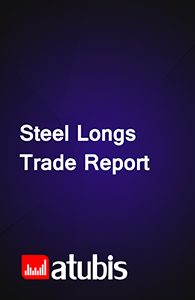Turkey’s Steel Sections Market Outlook Report
475,000 ₺
- EUR: 9,680€
Steel sections include beams with H and I cross sections as well as other products with T, Z, and U cross sections. I-beams are the most commonly used steel sections. The infrastructure sector also uses steel sections in bridges, steel structures, and wharfs. Estimates suggest that Turkey’s sections market will have relative growth in the coming years.
Product Description
With a GDP of $761 billion in 2019, Turkey was the second largest economy in the region that year, behind Saudi Arabia. The country joined the Economic Cooperation Organization in 1961 and also became a member of G20 in 1991. However, Turkey is still a developing country, according to the UN in 2019. With an annual output of 35 million tonnes of crude steel, the country is the largest producer in the region. The country is also a regional leader in HRC production.
Market drivers of Turkey’s steel sections
The share of the manufacturing sector in Turkey’s economy has increased over the past years, owing to increased industrialization. Along with industrial development, demand for steel as the most commonly used industrial metal will strengthen. The uptrend in the share of the manufacturing sector in the country’s economy is expected to continue over the coming years, driving demand for steel along with the growing industrialization. The consumption of steel sections in the construction industry is the most important application of these products; the mechanical properties of steel sections have resulted in considerable demand.
The auto industry is one of the largest consumers of steel in Turkey. The sector has had significant growth over the past years to make the country the second largest producer of commercial vehicles in Europe and the fifth largest producer of passenger vehicles in the region. With a nationalistic approach over the recent years aimed at producing domestic cars that can lead global markets, the industry has attracted massive investment; over the past two decades, more than $800 million has been invested in the sector on annual average. As government support for electric vehicles increases, the industry is expected to continue its accelerated growth. This can significantly boost demand for steel and steel products.
Turkey reported the first case of Covid-19 in the latter half of March 2020. Not much longer, in mid-April, daily confirmed cases exceeded 5,000 and the country was officially facing a pandemic. To fight the pandemic, the government restricted businesses and ordered nation-wide lockdowns. As a result, the country’s mobility index dropped to around 60%. Thus, Turkey’s real GDP growth is forecast to be around -1%. With the restrictions implemented by the government due to the Covid-19 pandemic, demand for most steel products will weaken. Moreover, the spread of Covid-19 in Turkey’s export destinations will weigh on the country’s exports.
Overview of Turkey’s steel sections market
A look at the capacities, output, and consumption of steel sections in Turkey shows that the market has been well developed. Morocco is the major export destination, while imports are mostly from Spain. Based on estimates, supply is expected to continue to exceed demand and the oversupply will persist.
Breakdown of Turkey’s steel sections market
Domestic demand for steel sections in the forecast timeframe as well as the previous period has been broken down using three factors. The first factor breaks down the market into three categories: carbon steel, alloy steel, and stainless steel. Past and future trends for each type of material have been analyzed. Carbon steel sections hold the largest share of the market. In the second breakdown, products are distinguished based on cross section: beams, angles, T sections, channels, and Z sections; beams hold the largest market share. Finally, using the third factor, steel sections are categorized based on their applications in different industries. The construction industry is the largest consumer of steel sections in Turkey.
Key players in Turkey’s steel sections market
- OZHAN HADDECILIK SAN VE TIC A.S
Additional Information
| Industry | Steel Beam |
|---|---|
| Region | Turkey |
| Report Type | Industry Report |
Specifications
| Report Attribute | Details |
| The base year for estimation | 2020 |
| Historical data | 2010-2019 |
| Forecast period | 2020-2025 |
| Quantitative units | Value in USD and Volume in Tonne |
| Report coverage | Market Overview, Dynamics, Market Outlook, Risks to Forecast, Consumer Market, Industry Overview, Market Landscape, Competitive Landscape, Market Attractiveness, External Macro Environment Analysis |
| Segments covered | Composition, Type, Application |
| Pricing and purchase options | Please explore our purchase options to meet your exact research needs. |
Reasons to Buy
- Recognize the geographical distribution of import demand
- Identify the current and future key players of the trading market
- Achieve a better insight on potential target markets
- Understand the behavior of major suppliers/customers either globally or regionally
- Identify competitors as a feed for market analysis
Table of Content
- Executive summary
- Introduction
- Objective
- Market under study
- Product
- Product specifications
- Consumption structure
- Applications
- Physical properties
- Subjects discussed
- Geographical scope under study
- Study timeframe
- Study currency
- Potential audience
- Market dynamics
- Market drivers
- Restraints
- Opportunities
- Challenges
- Market overview
- Market size
- Industry capacities
- Existing capacities
- Capacity distribution
- Geographical distribution of capacities
- Future capacities
- Existing capacities
- Output
- Output trends
- Operating rates
- Consumption
- Consumption trend
- Consumption Share of domestic product
- Trade
- Exports
- Imports
- Trade balance
- Market balance
- Market breakdown by product type
- Market breakdown by product type
- Market breakdown by application
- Inventory
- Producers inventory
- Consumers inventory
- Traders inventory
- Market outlook
- Market factors
- Raw materials
- Costs and prices
- Competition
- The government
- Other factors
- Future scenarios
- Risks to forecast
- Market factors
- Consumer markets
- End-user markets
- Building construction
- Infrastructure construction
- Transportation manufacturing
- Industrial equipment manufacturing
- Durable goods manufacturing
- Consumable goods manufacturing
- Direct consumer markets
- Major Direct consumers
- Existing capacities
- Drivers
- Major Direct consumers
- End-user markets
- Export potentials
- Destinations
- Trade and insurance costs
- Import market suppliers
- Producers potential share
- Destinations
- Industry overview
- Raw materials
- The supply volume of raw materials
- Supply channels of raw materials
- Raw materials procurement costs
- Cost structure of producers
- Production cost curve
- Industry value added
- Generated new scrap
- Technology
- Raw materials
- Market landscape
- Domestic sales markets
- Pricing in the domestic market
- Potential domestic demand
- Trade agreements for imports
- Foreign suppliers
- Foreign sales market
- Prices
- Potential markets overview
- Trade agreements for exports
- Foreign customers
- Domestic sales markets
- Competitive landscape
- Producers
- Company profile
- Revenue structure
- Gross profit margins
- Capacity, output and sales
- Consumers
- Company profile
- Revenue structure
- Gross profit margins
- Capacity, output and sales
- Producers
- Market attractiveness
- Industry rivalry
- Threat of new entrants
- Threat of substitutes
- Bargaining power of buyers
- Bargaining power of suppliers
- Conclusion of Porter analysis
- PESTEL analysis
- Political factors
- Economic factors
- Social factors
- Technology factors
- Environmental factors
- Legal factors
- SWOT analysis
- Large-scale companies with favorable conditions
- Short-term strategies
- Long-term strategies
- Large-scale companies with unfavorable conditions
- Short-term strategies
- Long-term strategies
- Small enterprises with favorable conditions
- Short-term strategies
- Long-term strategies
- Small enterprises with unfavorable conditions
- Short-term strategies
- Long-term strategies
- Large-scale companies with favorable conditions
List of Figures
- Output and consumption; 2010-2019
- Market share of product applications; 2019
- Market surplus; 2019-2025
- Production process flowchart
- Market size; 2010-2025
- Existing capacity; 2010-2019
- Capacity distribution; 2019
- Geographic distribution of capacities; 2019
- Development of future capacity; 2010-2025
- Amount of output; 2010-2025
- Operating rates of production plants; 2010-2025
- Amount of consumption; 2010-2025
- Consumption share of domestic product; 2010-2025
- Exports of product; 2010-2019
- Imports of product; 2010-2019
- Historical trade balance; 2010-2019
- Future Market balance; 2021-2025
- Market output breakdown by alloy type; 2010-2025
- Market consumption breakdown by alloy type; 2010-2025
- Market balance breakdown by alloy type; 2010-2025
- Market output breakdown by product type; 2010-2025
- Market consumption breakdown by product type; 2010-2025
- Market balance breakdown by product type; 2010-2025
- Market consumption breakdown by application; 2010-2025
- Inventories of raw materials and products at producers factories; 2010-2019
- Consumers’ inventory of product; 2010-2019
- Traders’ inventory; 2010-2019
- Production forecast, according to raw materials and sales analysis; 2019-2025
- Market surplus; 2019-2025
- The share of end-user industries in the consumption; 2010 and 2019
- Changes in the end-consumption of extrusion products; 2019 vs 2025
- Applications in building construction industry; 2019
- Applications in infrastructure construction industry; 2019
- Applications in transportation manufacturing industry; 2019
- Applications in industrial equipment manufacturing industry; 2019
- Applications in durable goods manufacturing industry; 2019
- Applications in consumable goods manufacturing industry; 2019
- Capacity distribution structure of direct consumers; 2019
- Existing capacities of direct consumers in each province; 2019
- Suppliers of the export potential destination; 2019
- Historical exports to the export potential destination and future potential; 2016-2025
- Up-stream domestic supply; 2010-2019
- Raw materials domestic supply; 2010-2019
- Supply channels of producer plants
- Spot price of raw material in the market; 2010-2025
- Cash cost structure for production the product; 2019
- Production cost curve of the plants; 2019
- Gross value added of the industry; 2010-2019
- Generated new scrap; 2010-2019
- Sales channels
- Realized price of the product in the market; 2010-2025
- Potential demand of each province; 2019
- The main foreign suppliers to the market; 2010-2019
- FOB price vs domestic market; 2010-2025
- Map of global major importers > 20,000t; 2019
- Major foreign customers; 2010-2019
- Revenue structure of the producers; FY2019
- Sales income and gross profit margin of the producers; FY2010-2019
- Output and sales of the producers; FY2010-2019
- Revenue structure of the consumers; FY2019
- Sales income and gross profit margin of the consumers; FY2010-2019
- Output and sales of the consumers; FY2010-2019
- SWOT matrix for large-scale companies with favorable conditions
- Strategies positioning for large-scale companies with favorable conditions
- SWOT matrix for large-scale companies with unfavorable conditions
- Strategies positioning for large-scale companies with unfavorable conditions
- SWOT matrix for small enterprises with favorable conditions
- Strategies positioning for small enterprises with favorable conditions
- SWOT matrix for small enterprises with unfavorable conditions
- Strategies positioning for small enterprises with unfavorable conditions


